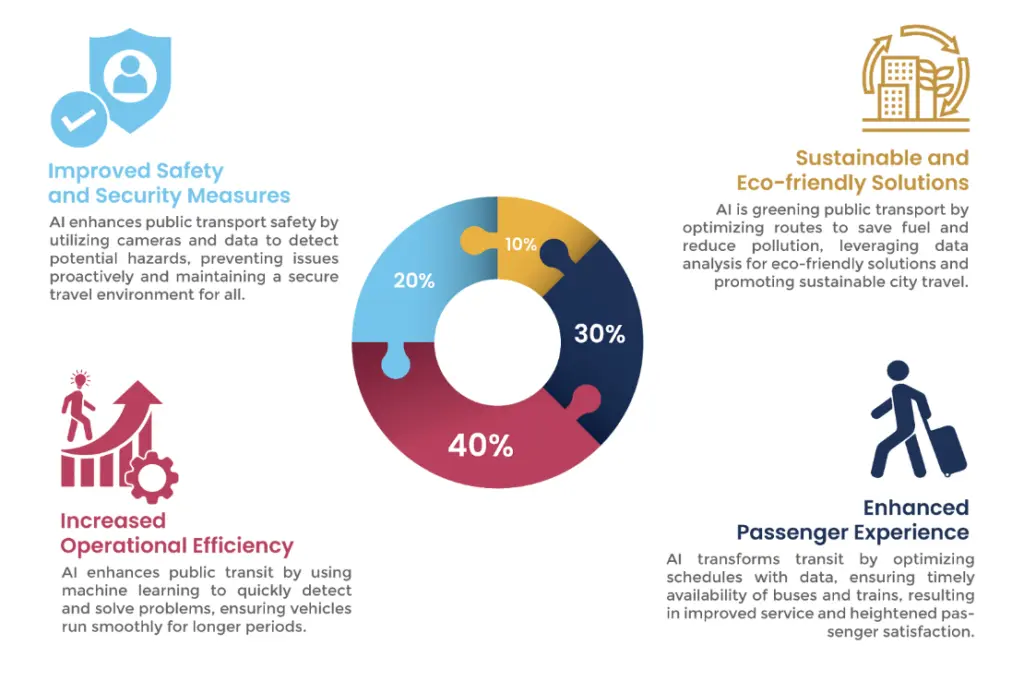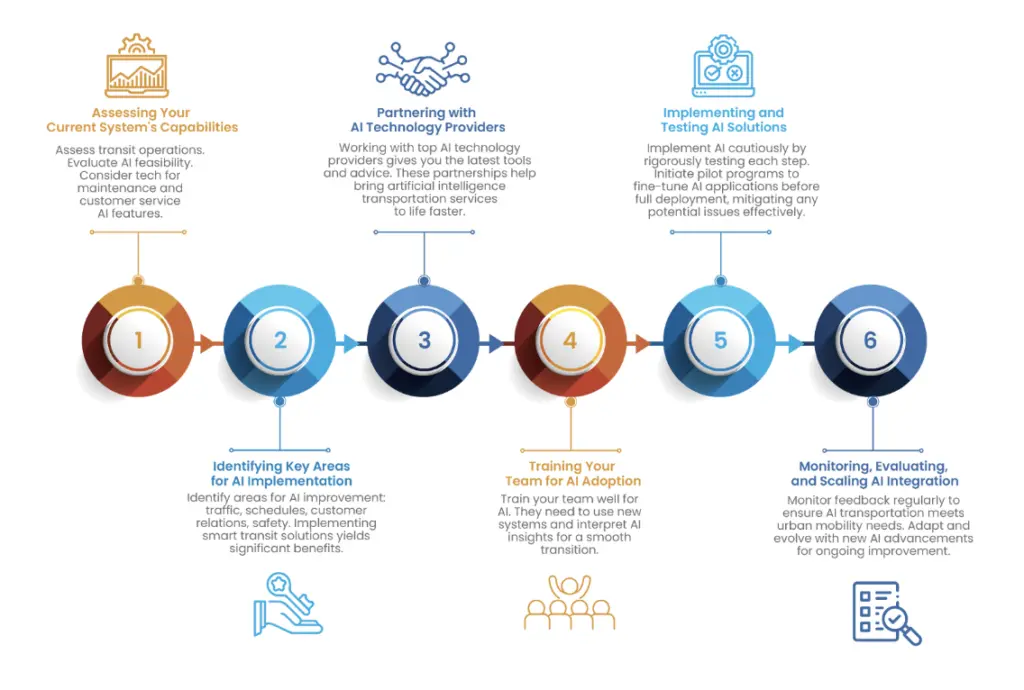How to Integrate AI in Public Transport Systems for Efficiency
 8 May 2024
8 May 2024? Listen to the Summary of this article in Audio
The idea that smart machines could make our daily commutes better is now a reality, not just a dream for sci-fi fans. By bringing AI in public transport, the busy and often chaotic travel in cities is becoming smoother and more predictable. This marks a shift from old ways to innovative approaches, introducing a new phase of smart transportation solutions. Imagine a world where artificial intelligence in transportation isn’t just an ambitious goal. Now, it’s a handy tool transforming our movements, jobs, and lives in cities.

The growth of AI in transport it’s essential as cities grow and the need for sustainability is more critical. By making bus routes better and trains on time, we do more than save time. We conserve energy, lessen stress, and support a healthier environment. But what’s the journey from present to future in transport? Let’s explore the functions, chances, and real-life uses of these advanced mobility solutions.
Key Takeaways
- Understanding the transformative potential of AI in public transport for enhanced operational efficiency.
- Discovering how smart transportation solutions leverage data to improve passenger experiences.
- Exploring the impact of automated transportation systems on urban sustainability and safety.
- Insights into the application of machine learning in public transport for predictive maintenance and routing.
- Examining the integration process and the future landscape of artificial intelligence in transportation.
- Highlighting the balance between technological advancement and public trust in transition toward smarter transit.
The Role of AI in Modern Public Transportation
AI in public transit is changing how we move in cities. It’s creating a smart, efficient way to travel. This new era in mobility combines speed with designs focused on people. Intelligent transport systems are the base of a future. Here, transit responds quickly and knows what will happen next.
Imagine AI woven into the operations of transit systems. It’s changing how we monitor flow and improve schedule accuracy. AI uses past and live data to better routes and traffic flow. This cuts down on waiting and makes riders happier.
The adoption of AI in public transit is not a mere enhancement but a transformative agent inducing a new era of mobility, equipped to anticipate the needs of passengers and urban spaces alike.
AI-powered surveillance is changing safety in transit. It’s great at spotting problems and predicting risks. This makes transport safer, doing what humans do but without mistakes.
- Route Optimization: AI decodes traffic data to guide buses and trains smoothly.
- Dynamic Scheduling: AI swiftly adjusts to changes, offering new paths and times.
- Safety Management: With smart tech, surveillance systems prevent dangers before they happen.
AI in transit does more than just take you places. It offers a trip that’s quick, safe, and pleasant. It’s about meeting your needs with smart, careful planning.

Key Benefits of Integrating AI into Public Transit
Artificial intelligence is changing urban travel in big ways. It makes public transport systems smarter and more efficient. This helps in cutting costs and offering better service. AI helps buses and trains take the best routes. This meets the need for better and smarter ways to travel in cities.
#1: Increased Operational Efficiency
AI boosts how well public transit works. It uses machine learning to spot and solve problems quickly. This means it can fix issues before they happen. This keeps vehicles running smoothly for longer.
#2: Enhanced Passenger Experience
AI doesn’t just make transit systems run better. It also makes riding them a better experience. It uses data to make sure buses and trains are there when needed. This keeps passengers happy by making service better and more focused on their needs.
#3: Improved Safety and Security Measures
AI also makes public transport safer and more secure. It uses cameras and data to spot possible dangers. This helps stop problems before they start. It keeps the travel environment safe for everyone.
#4: Sustainable and Eco-friendly Solutions
AI is also making public transport greener. It finds the best routes to save on fuel and lower pollution. This is done by analyzing lots of data for the best ways to be eco-friendly. It’s making city travel more sustainable.

Real-World Examples of AI in Public Transport
AI in public transport is making big changes. It’s bringing automated systems and self-driving vehicles to cities. We see this in action around the world. AI is boosting how public transport works, offering a peek into the future.
AI-Powered Traffic Management Systems
AI has brought the future to city traffic control. It uses AI to make sense of complex traffic data. By considering past traffic, real-time data, and schedules, it helps control traffic. This reduces jams and improves traffic flow.
Smart Ticketing and Fare Collection
AI is changing how we pay for public transport. With smart ticketing, AI detects fare evasion and protects money. It also adjusts prices based on travel habits, benefiting both companies and travelers.
Predictive Maintenance for Transit Vehicles
Maintaining transit vehicles is key to keeping customers happy. AI uses data from sensors to predict and prevent issues. This reduces vehicle downtime and saves money on repairs.
Personalized Passenger Information Systems
Today’s commuters want info that’s tailored and up-to-date. AI provides this, offering news on timetables, delays, and seat availability. It learns from your travel habits to suggest the best routes for you.
Our AI solutions can optimize your public transportation system.

Steps to Integrate AI into Your Public Transit System
Starting to use artificial intelligence transportation, you need a good plan. The move to smart transit solutions involves assessing your system. Then, it requires steps to add machine learning in urban mobility.
1. Assessing Your Current System’s Capabilities
First, review your current transit operations closely. Identify what works well and what doesn’t. This helps see if AI for urban transport can work for you. Think about the tech needed for AI features like maintenance systems and customer service.
2. Identifying Key Areas for AI Implementation
Then, find key areas in your transit system to improve with AI. Focus on traffic, schedules, customer relations, and safety. Creating smart transit solutions for these areas can bring big benefits.
3. Partnering with AI Technology Providers
Working with top AI technology providers gives you the latest tools and advice. These partnerships help bring artificial intelligence transportation services to life faster.
4. Training Your Team for AI Adoption
Training your team well for AI is key. They need to know how to use the new systems and understand AI insights. A well-trained workforce makes moving to AI smooth.
5. Implementing and Testing AI Solutions
Implement AI carefully, testing every step of the way. Start with pilot programs to adjust AI applications before going big. This approach reduces any issues.
6. Monitoring, Evaluating, and Scaling AI Integration
Last, always watch and review how things are going. Feedback helps make things better, ensuring the artificial intelligence transportation works well with urban mobility. Then, your system can grow and change with new AI tech.

Let our experts guide your move to AI-powered transit.
Challenges and Considerations in AI Integration
Urban areas are growing more complex, leading to the rise of AI in public transit. The advantages are obvious, but merging these systems with cities is hard. This piece highlights the main issues and what needs fixing for AI in public transport to succeed.
Data Privacy and Security Issues
Data privacy and security are huge concerns with autonomous transport. As they gather lots of user data, it’s crucial for officials and developers to build strong cyber defenses. This protects passenger info from hacks and misuse.
Regulatory and Compliance Challenges
The rules for autonomous vehicles in city transport are new and complex. Adapting to evolving laws requires quick action and talking with lawmakers. This ensures AI creators and laws work well together.
Infrastructure and Investment Requirements
AI in transportation needs big investments and planning. The costs for setting up and running AI systems are high. This includes putting in sensors and managing the systems.
Managing Public Expectations and Trust
Building trust in AI transport is crucial. These services need to be dependable and secure to gain public confidence. This means focusing on educating the public, being transparent, and proving AI reliability.
| Challenge | Impact on AI Integration | Strategies for Addressing |
|---|---|---|
| Data Privacy and Security | High risk to passenger trust if breached | Implement advanced encryption and cybersecurity measures |
| Regulatory Compliance | Must navigate varying global/regional standards | Active engagement in policy development processes |
| Infrastructure Investment | Significant upfront costs | Secure public-private partnerships and funding |
| Public Expectation Management | Essential for technology acceptance | Outreach and education campaigns |
Future Trends in AI and Public Transportation
The way we move in cities is changing fast. Thanks to new AI tech, public transport systems are getting smarter. Now, we are looking at a future where transport knows and does more than ever before.
Autonomous Vehicles in Public Transit
Self-driving vehicles are set to change public transit big time. They are not just high tech, but they also promise safer, more reliable rides. Everyone could see benefits from this major shift.
AI for Urban Planning and Traffic Optimization
Urban planners and traffic bosses are now using machine learning algorithms for public transportation. These smart programs can go through tons of data. They help make traffic smooth, cut down on jams, and get us to places faster.
The Role of Machine Learning in Predicting Transit Demands
Knowing how many people will use transit is key to running it well. Machine learning is great at predicting this by studying lots of data. This helps transit authorities make smart choices, balancing what we need with what they offer.
Integration of IoT with AI for Comprehensive Transit Solutions
AI and the Internet of Things (IoT) are joining forces, opening a new chapter for transit. This combo leads to better predictive maintenance in public transit. It keeps delays low and helps give updates and tips to travelers on the go.
| AI Innovation | Implication for Public Transit | Expected Benefits |
|---|---|---|
| Enhanced Predictive Maintenance | Timely servicing and repair of fleet and infrastructure | Improved reliability and reduced operational costs |
| Dynamic Route Optimization | Traffic pattern analysis for real-time route adjustments | Shorter travel times and decreased congestion |
| Transit Demand Forecasting | Demand-driven service planning | Better resource utilization and commuter satisfaction |
| AI-Integrated IoT Networks | Seamless vehicle-to-infrastructure communication | Comprehensive and responsive transit environment |
In the end, these tech advances are just the start of how AI will make public transport smarter. They promise to make our city travels easier, responding well to the hustle and bustle of city life. This is the future of moving around the world.
Our experts can help you navigate the challenges of integrating AI in public transit, ensuring data security, regulatory compliance, and public trust.
Conclusion
The use of artificial intelligence (AI) in transportation is opening new doors for how we get around in cities. These developments are changing public transport systems in real and practical ways. They mark a significant change in how things are done.
AI is taking over the management of buses, trains, and other public transport. This is possible by analyzing huge amounts of data. This improves how transportation systems operate, making them react to the needs of city life quickly.
With every iteration, machine learning in public transport edges closer to realizing a vision of transportation networks that anticipate, adapt, and advance to meet tomorrow’s demands.
AI is pushing urban areas towards smarter and more sustainable futures. The role of AI in transportation is more than making things convenient. It’s about drastically changing society, with every journey enhanced by smart, quick decisions.
- AI-driven route optimization for minimizing delays and reducing congestion
- Machine learning algorithms forecasting public transport demands
- Smart ticketing systems that streamline user experience and fare management
- Enhanced security and safety measures through intelligent monitoring systems
By adopting AI, public transportation becomes better and more eco-friendly. These are exciting times with big changes all thanks to human creativity. Each step towards smart transportation through AI helps us move towards a more sustainable and connected world. We’re pushing past old limits, driven by our innovation today and tomorrow.
FAQs
How is AI utilized in public transport systems to improve efficiency?
AI boosts public transport efficiency by optimizing routes and analyzing traffic trends. It schedules vehicles efficiently and streamlines ticketing. Also, AI enables predictive upkeep of vehicles for smarter operations.
What technologies are involved in AI-driven public transit?
AI-driven public transit uses several techs like data analytics and machine learning. It also relies on computer vision and IoT for device connection. Smart sensors gather real-time data too.
How does AI contribute to enhanced passenger experiences in public transportation?
AI makes travelling better by giving personalized trip advice and timely schedule updates. It simplifies payments through smart tickets. Plus, it keeps services reliable with vehicle and infrastructure maintenance.
Can AI in public transport lead to safer commuting?
Yes, AI makes commuting safer by foreseeing maintenance needs and analyzing surveillance for odd behaviors. It also controls self-driving vehicles, which lowers human errors. Safety standards are kept high.
What are some eco-friendly impacts of AI in public transportation?
AI helps public transport be greener by lowering fuel use via optimal routes. It eases traffic, supports electric vehicles, and efficiently uses resources by predicting service demand.
What real-world examples demonstrate the impact of AI in public transit?
Examples include smart traffic lights for smoother flows and self-driving buses in cities. There’s also rail network maintenance using predictive analysis, plus AI chatbots helping passengers.
How can public transit systems prepare for AI integration?
To gear up for AI, public transit should assess its infrastructure and spot AI improvement chances. Investing in tech, staff training, and slowly adding AI systems while checking their impact is key.
What are some challenges faced with integrating AI in public transportation?
The challenges involve maintaining data privacy and meeting standards. There’s the need for investing in tech and infrastructure. Managing public expectations and building AI trust are also crucial.
What does the future hold for AI in public transportation?
AI’s future in public transport looks bright with more self-driving vehicles and smarter urban planning. It’ll use predictive demand analytics and merge IoT with AI for smarter solutions.
How does AI help with privacy and security in public transportation?
AI improves security through sophisticated surveillance algorithms and anomaly spotting. It quickly identifies threats and shields passenger data using strong cyber-security methods.










